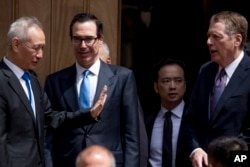U.S. President Donald Trump has ordered officials to begin the process of raising tariffs on “essentially all remaining imports from China,” valued at about $300 billion, according to the U.S. trade representative.
U.S. Trade Representative Robert Lighthizer made the announcement in a statement Friday after the United States increased tariffs from 10% to 25% on $200 billion worth of Chinese imports.
He said details on the process for a public comment period on the proposal for more tariffs will be published shortly.
The development comes after the United States and China ended their latest round of trade negotiations without announcing any agreement.
U.S. Treasury Secretary Steven Mnuchin and Lighthizer met briefly Friday with the Chinese delegation led by Vice Premier Liu He. After the talks, Mnuchin briefly spoke to reporters saying that discussions had been “constructive.”
After the talks ended, U.S. President Donald Trump tweeted Friday that the relationship with Chinese President Xi Jinping remains “a very strong one” and that conversations “will continue” but that the U.S. is imposing tariffs on China which “may or may not be removed.”
Earlier in the day, Trump sent a series of tweets on the escalating trade war with China. Beijing has vowed to retaliate for the U.S. action.
“We have lost 500 Billion Dollars a year, for many years, on Crazy Trade with China. NO MORE!”
Trump went on to tweet that trade talks with China are proceeding in a “congenial manner” and “there is absolutely no need to rush” to finalize a trade agreement.
The president noted that Washington sells Beijing about $100 billion worth of goods, and with the more than $100 billion in tariffs received, the U.S. will buy agricultural products from U.S. farmers and send them as humanitarian assistance to nations in need.
While some taxes are paid directly to the government when products are imported, these taxes, also known as customs duties, are frequently added to the price of the imported product. This means the taxes are paid by those who buy the product. In this case, it would be the American consumer.
Trump also chided China for trying to “redo” the deal at the last minute after the terms already had been set.
Trump said he also received “a beautiful letter” from Chinese President Xi Jinping that expressed a sentiment of “let’s work together.”
Trump told reporters he believes “tariffs for our country are very powerful,” and would benefit America’s economy.
Some economists, however, predict such tariffs would cut the U.S. economic growth rate.
David French of the U.S. National Retail Federation said in a VOA interview “a negotiating strategy based on tariffs is the wrong direction” and expressed hope the Chinese “make substantial concessions to avert this disaster.”
Shanghai University economics professor Ding Jianping told VOA the tariffs would also adversely impact the U.S. financial markets, which have climbed to record highs. Jianping said the record performance makes the markets “most vulnerable” because they are “not supported by science and technology.” He added, “The peak created by fiscal and monetary policy is unsustainable.”
The Trump administration hopes the new tariffs will force changes in China’s trade, subsidy and intellectual property practices. The two sides have been unable to reach a deal due, in part, to differences over the enforcement of an agreement and a timeline for removing the tariffs.






